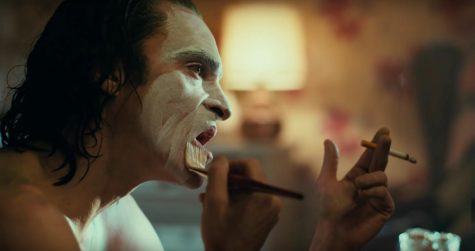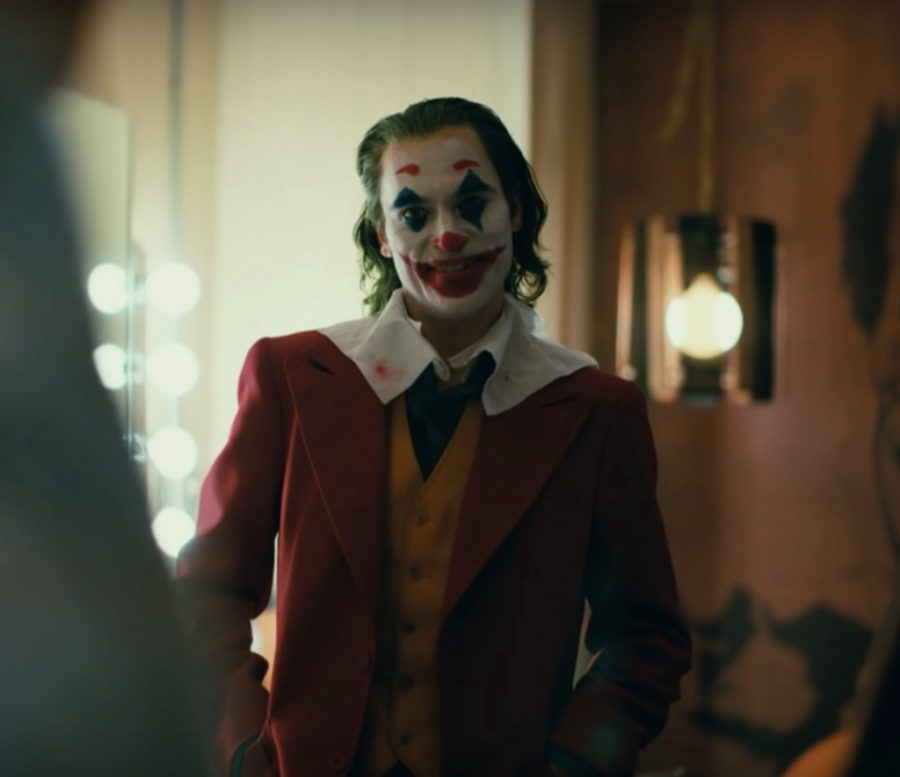Joker is no laughing matter
October 15, 2019
I saw “Joker” with my mom on a Friday night. I spent the first half hour flinching at every sound in the theater, at every person that stood up, terrified that some angry man invigorated by this film had come in to terrorize us. I spent the second half hour checking my phone to see how much time had passed. “Joker,” with all its dramatic shots and cello-heavy music, doesn’t pack the punch it thinks it does.
“Joker” follows Arthur Fleck (Joaquin Phoenix), a failed stand up comedian turned party clown, and his slow descent into madness as the world around him seems determined to beat him down.
From the premise alone it’s clear to see this Joker is unlike any of his previous iterations portrayed by the likes of Jack Nicholson, Mark Hamill and Heath Ledger. But this difference does not put the film at a disadvantage largely due to how intelligently Phoenix has remade this character. Although his version differs so drastically that comparisons can’t even be made, his portrayal still manages to feel true to the core of the character. Few, if any, actors can say they’ve done that, let alone with as much grace as Phoenix has. His Joker, with a skin and bones frame, is vulnerable, easily hurt (which he is, physically and emotionally, numerous times) and painfully unsure of who he is. But beneath it all, beneath the seeming weakness, there is a danger and intensity that Phoenix brings which is simply remarkable. He commands attention and, as the centerpiece, keeps the film going.

Arthur Fleck (Joaquin Phoenix) paints his face as he transforms into the Joker. The film, despite the uproar surrounding its release, doesn’t pack the punch it thinks it does.
But Phoenix’s performance isn’t enough to stop the film’s clunky pacing from dragging it down. “Joker” is, at times, unbearably slow—the entire first half feels more like a collection of random scenes and moments than a film. After Fleck’s first murder of three wealthy young men on a subway, the audience gets a first taste of what he is becoming, but then a half hour of nothing follows. The film takes unnecessary detours, exploring his childhood and a budding relationship with his neighbor that is later revealed to all be in his head. Had all these scenes been placed before the murder, they could have functioned as build-up to what should’ve been the snap, the moment that sparked his spiral into becoming the Joker. In choosing not to, the storyline became muddled, more of a self-important exploration of Fleck rather than a focused study of his transformation.
That is not to say there aren’t absolutely awe-inspiring moments. “Joker” is at its most impactful when they allow Phoenix to fully embody the title and have fun with the character. The first murder Fleck commits, for example, is impeccably made. The subway is one of the most important aspects of the scene and is used to its fullest, only adding to the tension. The rocking of the car and flickering lights as it goes in and out of tunnels help create an off-kilter and dangerous atmosphere. The use of lighting, framing and music are just as smart throughout the film, creating a world and feeling that belongs entirely to “Joker.”
One of the film’s final scenes is its strongest: Fleck stands atop a destroyed police car as Gotham—his city that stands as a symbol of inequality, corruption and ruin—is burning around him and citizens in clown masks surround him cheering. He reaches into his bloody mouth with both hands, spreading it up and out, painting a gruesome smile on his face. He extends his arms out, the music swelling, now a showman, a hero to the masses, and it cuts to black.
It is in these moments that the possible impact of this film is impossible to ignore. I was terrified when I went to see this movie, terrified that something was going to happen to me and my mom. Even so, I don’t want movies like this to stop being made, and that’s not to say we should charge full speed ahead, making more films like these without a care in the world. It is the job of art and media to say something about the human condition, to make you think. Stories like this, stories that can touch on class division and mental illness, deserve to be told. It is the way in which they’re told that makes the difference and, in this crucial sense, “Joker” missed the mark. The story too often victimized Fleck, basked in his violent tendencies and had his actions result in positivity. Additionally, the release of a film like this at a time like this, with mass shootings becoming all too common, is unquestionably, an odd and dangerous decision.
At its Venice premiere, “Joker” received an eight-minute long standing ovation. When I walked out of the theater, I felt nothing stronger than general contentedness with what I had just seen. “Joker” isn’t groundbreaking or revolutionary, it’s just a film like any other with its fair share of faults and strengths. And considering everything that has surrounded its release, I’m happy with just that.





Notunin Telligent | Oct 22, 2019 at 12:54 am
I honestly don’t know where to start, there’s just so much wrong with this article. Maybe I’ll just start with your complaint about the movie being too slow-paced. This complaint is honestly quite stupid, as that’s what the movie is. If you want some fast-paced film go watch the MCU. This movie is a character study, a psychological thriller/drama that transcends the typical superhero movie. A slow-burn is the best possible way to follow Arthur’s descent into madness, as it gives everything in more detail. Another issue with your argument is this quote: “The film takes unnecessary detours, exploring his childhood and a budding relationship with his neighbor that is later revealed to all be in his head.” This is the opposite of a detour. The revelation of his relationship with her being fake is one of the most important parts of the film. This is because it is clearly displayed to us then that the movie is Arthur’s first-person narration, where any scene could be fake, giving a whole new meaning to the film. There’s a bigger issue here though, as I really do not think your first sentence should be something you’d put into an official review. Your fear of a white man shooting up the theater is not the movie’s fault, but the media’s. As of right now, 3 weeks after the premiere and after $700 million, absolutely nothing bad has happened during Joker screenings. The whole “controversy” was completely stirred up by left-wing media, specifically CNN. What’s even worse about your statement is that it just shouldn’t be something you say in public. If you stated any other race you would likely be in a lot of trouble and shunned by people for being racist. Overall, that sentence was an extremely unnecessary addition to an article that’s supposed to be reviewing the movie, and at best the statement is an irrational and ridiculous statement purely out of paranoia influenced by what you heard through the news.
Editorial Board | Nov 13, 2019 at 10:12 pm
Thanks for your feedback. We agree that saying specifically a “white” man was an overgeneralization and have accordingly reviewed and updated the article.